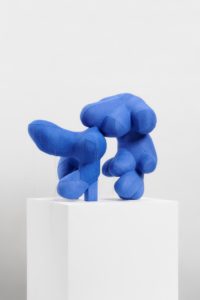If Lauren DiCioccio’s chosen materials of fabric, thread and found objects at first appear playful and lighthearted, a closer look reveals the disturbing little works assembled in “Comfort Objects” as apropos of the collective mood of wariness, of the persistent feeling that our world has shifted into some improbable dystopian shape. Her latest exhibition at Jack Fischer Gallery’s Minnesota Street Project location presented an assortment of the artist’s stuffed fabric sculptures in small-to-medium scale, along with three works cast in bronze.
A hip-high pedestal bisected the compact gallery, while a ledge/pedestal of the same height projected from the back wall, creating a T-shaped structure that divided the room. While many of the works provide brilliant bursts of color—DiCioccio hand-dyed some of the fabric to achieve just the hues she wanted—two of the works are stark black. Harbinger (all works 2016), in the left corner of the room, hovers at the tallest height. Found shoe trees are incorporated in this object, perched on three of four protruding wooden “feet” daubed unevenly with black. Irregularly formed appendages protrude at unexpected angles, suggesting, as many of these works do, animated beings as well as stuffed animals; the tips of the shoe trees also peek out from above, suggesting wings or perhaps oversize claws, or flippers. This work, like its Poe-inflected companion, Uncommon Raven, has an ominous feeling to it, a harbinger, one must assume, of doom.

Lauren DiCioccio, Elephant in the Room, 2016, ©Lauren DiCioccio, courtesy of the artist and Jack Fischer Gallery, San Francisco.
Creamcyclical, in a pale shade of pastel orange, suggests the frozen confection alluded to by the title (an ice cream bar of vanilla wrapped in citrus coating) and so much more. Thin wooden slats intersect the fabric forms, which are roughly spherical, three of the ends touching down on the points of their corners to create a delicate tripod. This improbable structure seems certain to collapse under its own weight.
All the fabric works, which are hand-stitched from small pieces of cloth, are quilted together and fitted with darts to create tautly-stuffed, assertive forms proud of their lumpy and quirky nature. As in earlier works, such as embroidered replicas of The New York Times articles, DiCioccio uses the device of dangling threads—drawing our attention to the process of their making and creating snaking tendrils of energy. If alluding to stuffed animals, it is to ones cuddled beyond recognition. One might have flickering thoughts of encounters with Mike Kelley’s sad cloth menageries. Enigmatic, surreal sculptures, such as those of Jean Arp, certainly inform the work as well.
Individually, the works engage us in their particular forms and energies, some dark and moody, others resonating an off-beat joie de vivre. Taken as a whole, they may reflect an affection and commitment to commingling of differing entities, a nod to the “melting pot” which has historically symbolized our nation. Indeed, Green of Grace reflects the Statue of Liberty—inspiration for DiCioccio’s forays into the medium of bronze. With an uncertain future, one may cling to whatever objects bring solace, while keeping as well an anxious vigil.


